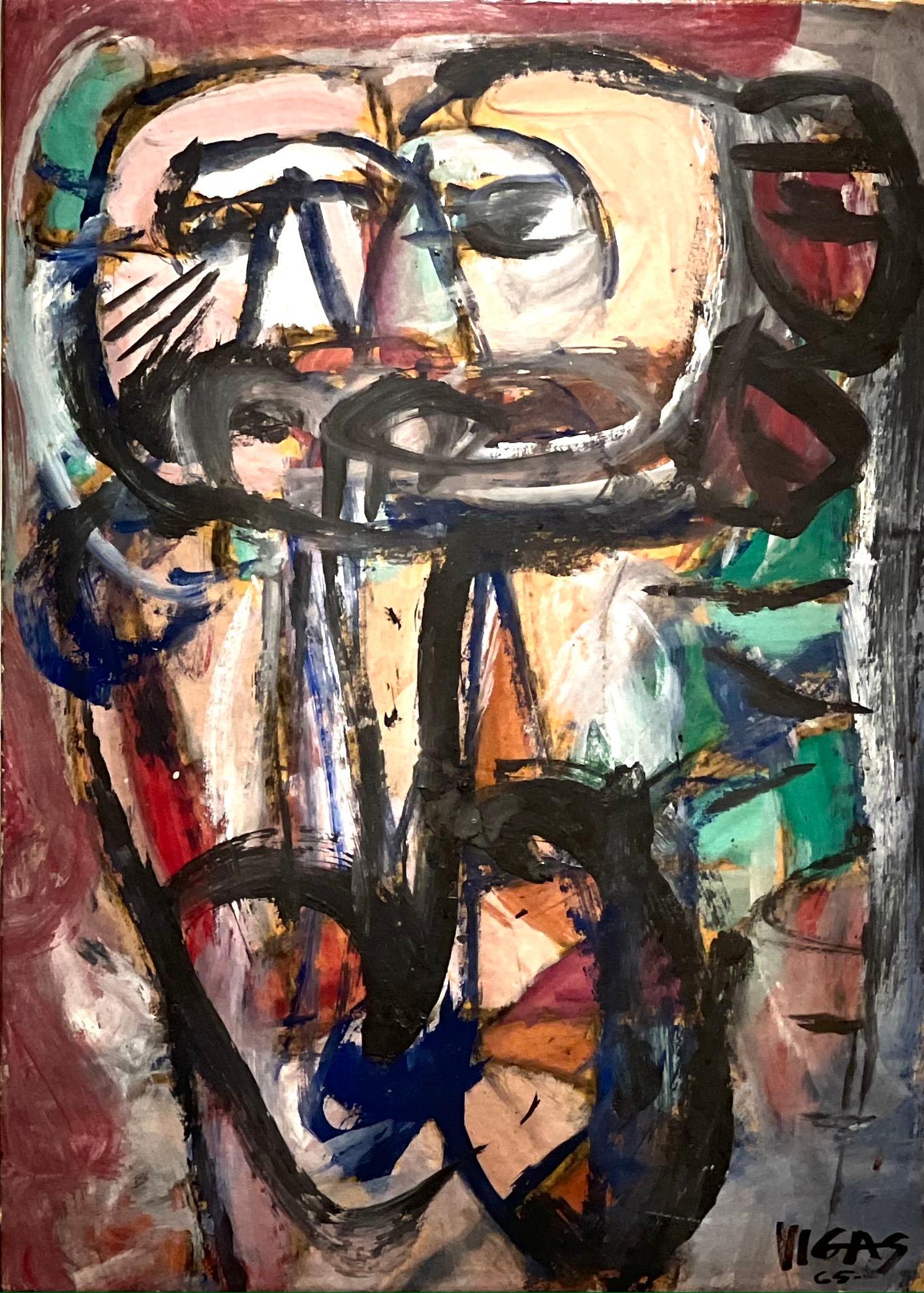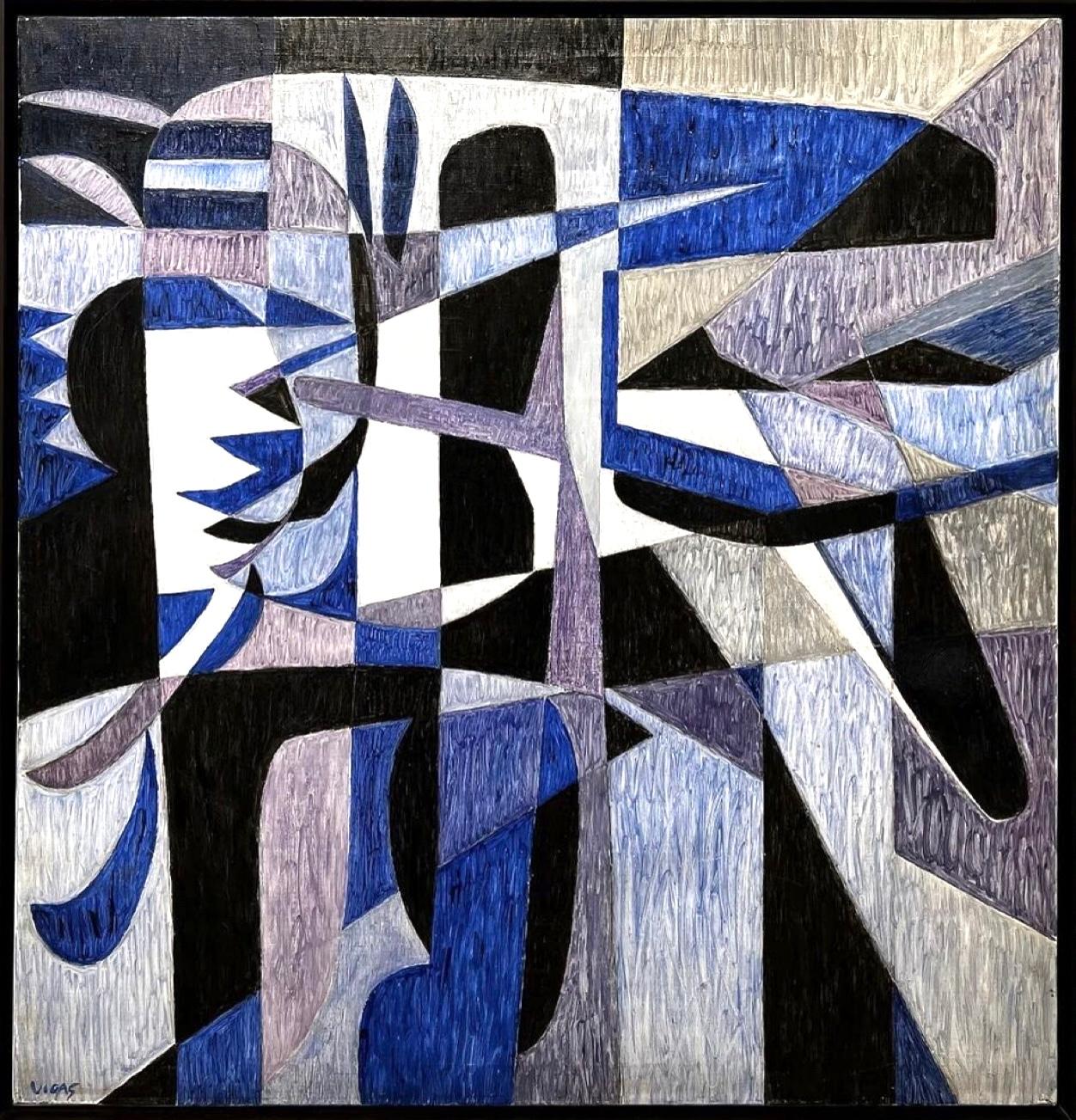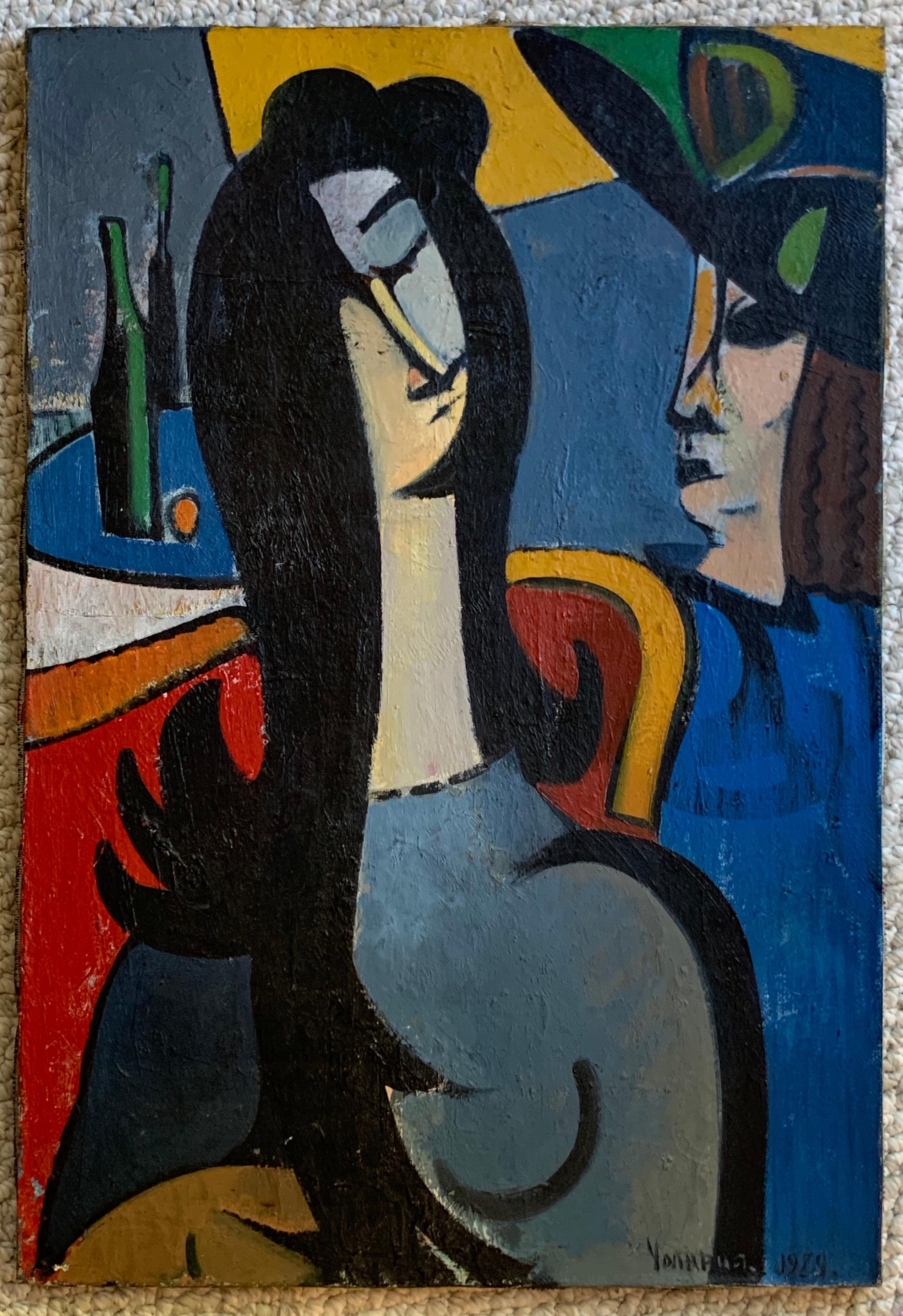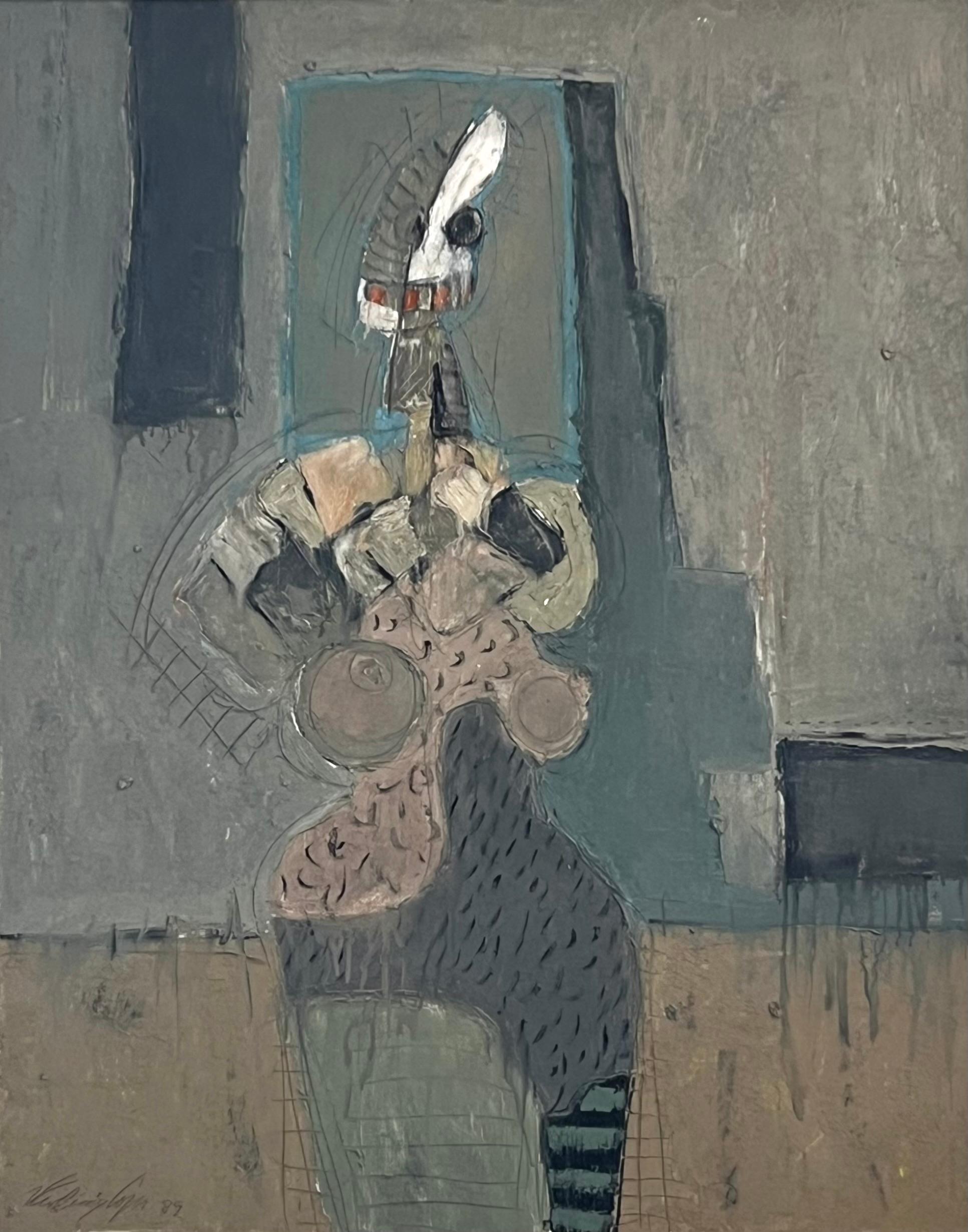Items Similar to Israeli Cubist Modernist Oil Painting "Rosh Shiryon Abir" Armor
Want more images or videos?
Request additional images or videos from the seller
1 of 10
Shlomo ZafrirIsraeli Cubist Modernist Oil Painting "Rosh Shiryon Abir" Armor 1964
1964
About the Item
Shlomo Zafrir is active/lives in Israel, France. Shlomo Zafrir is known for cubist painting.
Shlomo Zafrir is a painter and, at the same time, the owner of a nightclub called Omar Khaim located in Old Jaffa. The building housing the nightclub is hundreds of years old and, as its name suggests, is of oriental or mid-eastern flavor. Mr Zafrir paints realistic oils of the young people of Jaffa as a specialty along with paintings of the Port of Jaffa. He has exhibited his art in New York and Philadelphia. As far as the nightclub is concerned, it catered to those who enjoy folk singing and was apparently very successful. In 1958 the Icelandic Pop Artist Erro spent 8 months working with Zafrir in his studio. He was also the teacher of Israeli contemporary artist Ted Barr.
Filmography
Art director
1979 Worlds Apart
1973 Kazablan
1972 Salomonico
1965 Trunk to Cairo (as S. Zafrir)
Art department
1973 Kazablan (set designer - as Shlomo Tsafrir)
Set decorator
1988 Appointment with Death (as Shlomo Tzafrir)
- Creator:Shlomo Zafrir (1926 - 2002, French, Israeli)
- Creation Year:1964
- Dimensions:Height: 18 in (45.72 cm)Width: 13.75 in (34.93 cm)
- Medium:
- Movement & Style:
- Period:
- Condition:minor wear, minor chips.
- Gallery Location:Surfside, FL
- Reference Number:1stDibs: LU38213283162
About the Seller
4.9
Platinum Seller
These expertly vetted sellers are 1stDibs' most experienced sellers and are rated highest by our customers.
Established in 1995
1stDibs seller since 2014
1,549 sales on 1stDibs
Typical response time: 1 hour
- ShippingRetrieving quote...Ships From: Surfside, FL
- Return PolicyA return for this item may be initiated within 3 days of delivery.
More From This SellerView All
- Abstract Mixed Media Collage Oil Painting Sports, Leather Baseball MittsBy Patrick LoCiceroLocated in Surfside, FLTitle: (Baseball) Mits 25.5" W x 25.5" H x 2.25" framed; canvas measures 24" W x 24" H. Provenance: The Rails Collection, Washington, DC (with their label verso) This depicts floating baseball gloves inn an abstract pattern. This is not signed on the front and might be signed verso. We have not examined out of frame. Patrick LoCicero was born in Youngstown, Ohio, in 1959. He attended Youngstown State University, Ohio, and the Columbus College of Art and Design. He completed a B.F.A. at Ohio State University in 1982 and an M.F.A. at the San Francisco Art Institute in 1986. His paintings, installations, prints, and multimedia work have been shown in California, Pennsylvania, and Ohio. LoCicero's richly layered imagery is characterized by unusual juxtapositions of everyday objects and classical motifs, which play with the viewer's perception of materials and subjects. LoCicero’s assemblage paintings combine collage with painting. The overlap and collage elements relate directly to the images he depicts, guiding him in his choice of subjects, and come from a variety of sources including the Kama Sutra, antique children’s books...Category
21st Century and Contemporary Contemporary Abstract Paintings
MaterialsCanvas, Mixed Media, Oil, Acrylic, Laid Paper
- French Jewish Post Holocaust Abstract Painting Manner of Hundertwasser Art BrutBy Jichak PressburgerLocated in Surfside, FLJichak Pressburger, Painter. b. 1933, Bratislava, Czechoslovakia. A concentration camp survivior. Came to Israel aboard the ship, "The Exodus". 1964 Went to Paris. In 1979 Returned as new immigrant. Education Tel Aviv University, B.A. in art, with Marcel Janco and Isidor Ascheim at Avni art school. Beaux Arts, Paris with Professor Coutaud. Itzchak Pressburger Stays in Paris from 1963 – 1979, Resident of the “Cité des Arts” 1969-1972. Lives and works in Jerusalem since 1979. One-Man Exhibitions 1963 Gallery Dugit, Tel-Aviv 1968 Cultural Center Enkhuizen, Netherlands 1968 Gallery Zunini, Paris (chosen by the art critic of « Opus : Jean-Jacques Lévèque) 1970 Gallery Zunini, Paris 1973 Gallery Maitre Albert, Paris. Cultural Center Verfeil sur Seye, France 1974 Gallery Maitre Albert, Paris 1976 Gallery Mundo, Barcelone 1980 Artists’ House, Jerusalem 1981 Gallery Alain Gerard, Paris Group Exhibitions 1966 Rathaus Charlottenburg, Berlin. (The first show of Israeli painters in Germany Artists Center of Silvarouvres, Nantes, Ffance XXXth Salon of Finances at “l’Hotel des Monnaies”, Paris 1969 Maison de Culture, Le Havre, France 1968 Gallery Zunini, Paris (chosen by the art critic of « Opus : Jean-Jacques Lévèque) Salon « Grands et Jeunes d’Aujourd’hui », Paris Museum of Fine Arts, Nantes, France Cultural Center Vitry, France Gallery Il Giorno, Milan Cité des Arts, Paris 1972 Salon “Grands et Jeunes d’Aujourd’hui”, Paris Salon de Mai, Paris 1973 Städtische Galerie, Siegen, Germany 1974 Jewish Cultural Center, Paris Publicis, Paris 1975 Réalitiés Nouvelles, Paris 1976 Salon de Mai, Paris 1977 “Perspectives Israeliennes”, Grand Palais, Paris 1981 Salon Alain Gerard, Paris 1984 Artists’ House, Jerusalem Publication 1990 Haggadah Yom Kippour (Hebrew/French) Abraham Bliah (private edition), Paris Acquisitions 1968 The City of Paris 1972 The State of France The Yitzchak Pressburger artist was born in Bratislava – known for centuries by its German name of Pressburg – but the outbreak of World War II found him and his family in Prague. His father realized they had to escape from the Nazi occupiers and tried to get the family across the border into Hungary. However, they were caught near the crossing point, arrested and incarcerated overnight at the nearby railway station. The Czechs put them on a train to Hungary early the next morning. That was their first miracle in their quest for survival. They survived with relative ease until late 1943, when the father was taken away to a forced labor camp. He subsequently died in a death march. Things became even more precarious in early 1944, when the Holocaust made its full-blown presence felt in Hungary. “It wasn’t the Germans, it was the Hungarian Nazis who did the dirty work,” Pressburger points out. The family lived in so-called “safe houses” that were protected by Switzerland, Finland and Sweden. The havens were dismantled in late 1944, and the Pressburgers moved into one of the two Jewish ghettos in Budapest. The Nazis had found two houses with Jews, including the one where we had been, and took them all out and shot them next to the Danube. Today there is a monument by the river [called Shoes on the Danube Bank]. We should have been with the Jews who were killed by the river,” he says. After the war, Pressburger and his siblings were farmed out to various orphanages run by the Jewish Agency, and things took a decidedly better turn. “We finally had food to eat,” he recalls. “After a while we were put on trains that were protected by the Jewish Brigade [of the British Army], and we were sent to Austria, and then to Germany.” “My uncle was a famous artist, and I learned a lot from him,” he says. While in Germany, Pressburger also took some lessons with a local artist. His mother managed to get him and two of his siblings berths on the Exodus, which set sail from Marseilles for Palestine in July 1947. Pressburger was 13 at the time and clearly recalls the aborted attempt to get to the Promised Land. “It was so crowded on the boat. This was a ship that was made to ply rivers in the United States, with a few hundred people on board, and we had over 4,500 passengers crammed in.” As we know, the British prevented the Exodus from docking in Palestine, and the passengers were shipped – in three far more seaworthy vessels – back to France. After the French government refused to cooperate with the British, Pressburger and the others found themselves back in Germany. The teenager eventually made it here in 1948, just one month before the Declaration of Independence. After a short furlough in Tel Aviv, during the first lull in the fighting in the War of Independence, he moved to Kibbutz Kfar Ruppin, where he worked in the cowshed. All the while he continued feverishly drawing and honing his artistic skills, which he says came in handy when he joined the IDF. After completing his military service, which included a spell as one of the founding members of the Flotilla 13 naval commando unit, he worked in Sdom for a while at the Dead Sea Works before starting his formal arts training in earnest. I was in the first group of students at the Avni Institute [in Tel Aviv],” he says. “There was quite a famous bunch of students and teachers like Moshe Mokadi and Isidore Ascheim and Aaron Giladi.” In such illustrious company, one might have thought Pressburger was set to unleash his burgeoning talents on art connoisseurs across the globe, but it was a while before that happened. Pressburger arrived in the French capital in 1964 and spent close to 15 years there, with a short interlude in Germany, before returning to Israel. His time in Paris was a professionally rewarding period of his life, and he also found love. “[Avni Institute teacher] Yochanan Simon gave me the name and address of a French-Israeli family in Paris, but when I got to the house, a young woman opened the door and told me the family was on vacation in Israel,” he explains. Despite missing his expected hosts’ welcome, he and the German-born young lady who greeted him soon fell for each other, and romance quickly led to wedding bells. By all accounts, Pressburger did well in Europe. He secured a rare three-year berth at Cité Internationale des Arts, where artists are normally provided with accommodation and studio space for between two months and a year. He was also accepted to the prestigious Beaux Arts academy of fine arts, mounted solo exhibitions, and took part in group shows all over Europe. One of these last was a group exhibition at Rathaus Charlottenburg in Berlin in 1966 – the first exhibition of Israeli artists in Germany after the Holocaust. When he arrived in Berlin, the lineup for the Israeli show was already signed and sealed, but somehow his work came to the attention of the German culture minister, who arranged for him to join. The Pressburgers’ year-long sojourn came to an abrupt end following an encounter he had one day while walking through the crowded Berlin streets...Category
1960s Expressionist Abstract Paintings
MaterialsCanvas, Oil
- Abstract Procession Jewish Wedding Chuppah Oil Painting Modernist JudaicaBy Sabina TeichmanLocated in Surfside, FLGenre: Modern Subject: Abstract Medium: Oil Surface: Canvas Country: United States Sabina Teichman: (1905-1983) Studied at Columbia Univ. (BA, MA), also with Charles J. Martin and A...Category
1950s American Modern Figurative Paintings
MaterialsCanvas, Oil
- Judaica Modernist Oil Painting 'Know Thyself' Israeli Kibbutz Pioneer, ProphetBy Mortimer BorneLocated in Surfside, FLMortimer Borne, Printmaker, painter, sculptor, and educator was born in Rypin, Poland in 1902 and emigrated to the US in 1916. He studied at the National Academy of Design, The Art Students League, The Beaux-Arts Institute of Design, and with Charles Webster Hawthorne, founder of the Cape Cod School of Art in Provincetown. Painted in a thick impasto style similar in technique to Samuel Rothbort and David Burliuk. Borne himself taught at The New School for Social Research in New York City from 1945-1967. From the 1920s through the 40s he was a prolific producer of New York City cityscapes and genre scenes. In later decades, he adopted a more modernist style apparently influenced by Picasso, producing color drypoints of abstracted figures. His works were widely exhibited in museums in the U.S. and abroad from 1931 and later, including the Art Institute of Chicago, the American Institute of Graphic Arts, Museum of Modern Art, Metropolitan Museum of Art, Corcoran Gallery of Art, New York Public Library, Carnegie Institute, and Royal Society of Painters, Etchers and Engravers in London. He taught at The New School for Social Research in New York City from 1945-1967, and at the Tappan Zee...Category
1970s Modern Figurative Paintings
MaterialsCanvas, Oil
- Peruvian Expressionist Oil Painting Miguel Aybar Modernist Latin American ArtLocated in Surfside, FLDimensions: (Frame) H 28.5" x W 35.5" (Painting) H 22" x W 30" Miguel Ángel Aybar Llauca, an artist specializing in expressionist painting, was born in Huancavelica and lives in the city of Ica where he began drawing from a very young age, drawing from its beautiful valleys and customs. In 1970 he began his studies in Drawing, Painting and Sculpture at the Regional School of Ica. He is a graduate of the National Superior Autonomous School of Fine Arts of Peru (1971-1976) with honorable mention, forming the promotion "Juan Manuel Ugarte Eléspuru". "Iqueño Expressionism" is the title of the exhibition that will be available to the public from May 25 to June 13 in the "Paracas" Room of the "Adolfo Bermúdez Jenkins" Regional Museum of Ica. Av. Ayabaca block 8°. Miguel Angel Aybar is a painter who characterizes expressionism in Ica without a doubt. His songs speak of longing, and secret friendships with the hurango, the palm tree of Huacachina or the silent and still sand of Ica. His work is primarily characterized by color. The contrasts between the intense dark contrasted with the radiance of reds, oranges, yellows or greens, achieve a positive effect on the observer. Its warm tones reach high levels like an Ica sun at noon. However, among those quasi Servulian colors , Andean prints maintain their presence. Hats, ponchos or skirts hidden from a root bound by blood or memories. The perfect textures of his works give him the seal, the personality that characterizes a curdled and experienced Aybar who no longer needs to dialogue with the brush; they just flow, hand and brush. When entering the exhibition hall, you do not need to read the signature, he is an Aybar. There is no room for confusion. Although there are not a few artists from Ica who use these boiling tones, and I translate it as a tribute to that Sérvulo that touches you in the depths of your being, if you are an artist and you live in Ica, you want to be possessed by the ghost of the disturbing Sérvulo Gutiérrez turned legend. Servulus still catches the spectator being absorbed, as if observing a volcano, fearing that it might erupt, but with an inexplicable delight that he stops you next to him and captures you. However, Aybar no longer needs Servulo's shadow, he has gained an important space in the artistic world of Ica. He is an artist and a close friend of poets and musicians. Painter recognized by the Ica society and deserving of all the medals and recognitions by the different institutions. He not only paints with mastery, as Alberto Dávila predicted, when he said that his maturity would give him the position that corresponds to him. He now sings in public to the delight of his closest friends. Ica recognizes him as a son and has given him the place that corresponds to this remarkable painter whom I congratulate. DATA ABOUT THE ARTIST Miguel Angel Aybar Yauca, was born in 1952 in Huancavelica. He has lived in Ica since he was very young; he began his art studies at the Ica Regional School of Fine Arts. He later moved to Lima to study at the National Autonomous School of Fine Arts of Peru from where he graduated in 1976. His teacher Alberto Dávila described him as: a restless, imaginative young man with a sober and dramatic color. His forms acquire poise and great eloquence . Aybar also had the painter Carlos Aitor Castillo...Category
20th Century Expressionist Figurative Paintings
MaterialsCanvas, Oil
- Israeli KIbbutz Artist Toddler, Swim Tube Pointilist Oil Painting Bezalel SchoolBy Arie KaplunLocated in Surfside, FLBelarusian born Israeli artist. lived in germany studied at the Bezalel School. Bezalel Academy of Arts and Design is Israel's national school of art. Established in 1906 by Jewish...Category
20th Century Pointillist Figurative Paintings
MaterialsCanvas, Oil
You May Also Like
- Untitled, 1965By Oswaldo VigasLocated in Palm Beach, FLPredominantly recognized as a self-taught painter, he also worked in architectural murals, sculptures, ceramics, prints and drawings. Vigas is one...Category
1960s Cubist Figurative Paintings
MaterialsCanvas, Oil, Gouache, Board
- BelisamaBy Oswaldo VigasLocated in Palm Beach, FLPredominantly recognized as a self-taught painter, he also worked in architectural murals, sculptures, ceramics, prints and drawings. Vigas is one...Category
1960s Cubist Figurative Paintings
MaterialsCanvas, Oil, Gouache, Board
- Russian Cubist Portrait of a WomanLocated in Wilton Manors, FLBeautiful cubist portrait of a woman by unknown Russian artist. Oil on canvas measures 17 x 25 inches. Signed and dated lower right. Label fragments affixed on verso.Category
1980s Cubist Abstract Paintings
MaterialsCanvas, Oil
- Seated Woman Oil/Canvas 1989 Cubist Abstract Female Figure COLORFULBy Vladimir CoraLocated in Rancho Santa Fe, CAARTIST: Vladimir Cora MEIDUM: Oil on canvas Signed & dated lower left "Vladimir Cora 89" Painting dimensions 39 x 31 inches Framed dimensions 47 x 38 inchesCategory
1980s Cubist Abstract Paintings
MaterialsCanvas, Oil
- Romeo de Ravenne - Cubist Oil, Figure & Boat on Landscape by Camille HilaireBy Camille HilaireLocated in Marlow, BuckinghamshireSigned and titled oil on canvas by French cubist painter Camile Hilaire. The piece beautifully depicts a man at a port beside boats coloured in reds, blues and oranges. A wonderfully...Category
1960s Cubist Abstract Paintings
MaterialsCanvas, Oil
- SpiritBy William Y. CooperLocated in Buffalo, NY"Spirit" a bold and thoughtful cubist oil on canvas was painted in December of 2001 by African American artist William (Bill) Cooper. William Y. Cooper was a writer, painter, muralist, illustrator, and art teacher. He moved to Western New York in 1954 from Birmingham, Alabama, to pursue work, and Buffalo has been his home ever since. In 1975, he received his Bachelor of Fine Arts degree from the University at Buffalo; he was also a state certified art teacher. Cooper woked primarily in oils and acrylics, but also creates drawings on paper. He has painted several commissioned murals and has had more than fifteen one-man shows in Western New York and Ghana, West Africa, and has participated in more than twenty-five group exhibitions since he began his professional career in 1969. His paintings and drawings address both his African heritage and his experience as an American through symbolism and metaphor. He observes, “I am an Afrocentric artist. My worldview is rooted in an African frame of reference and a deep, abiding sense of the creator from whence I draw my inspiration, strength, and a sense of who I am. The use of symbols allows me to explore literal ideas.” Among Cooper’s published works are two children’s books, 77 Jackson Street, Rear and Nakai and the Red Shoes, and a novel for adults, The Mopane Tree. Cooper founded the Afrocentric Artists’ Collective and ran the organization from 1979 to 1981. In 2013 he was designated a “Living Legacy” artist by the Burchfield Penney Arts Center, the latest in a series of honors which has also included awards from the Arts Council of Buffalo & Erie County, the New York State Council on the Arts, and Alpha Kappa Alpha...Category
21st Century and Contemporary Cubist Abstract Paintings
MaterialsCanvas, Oil




